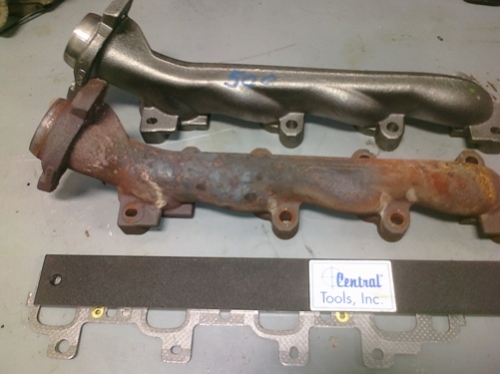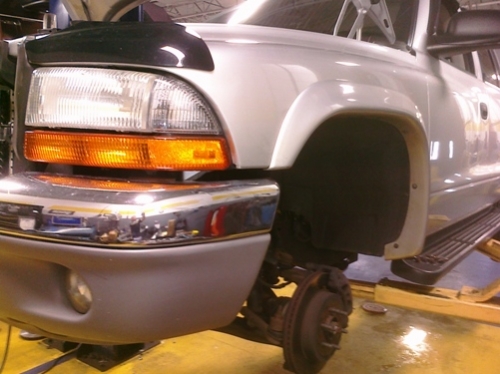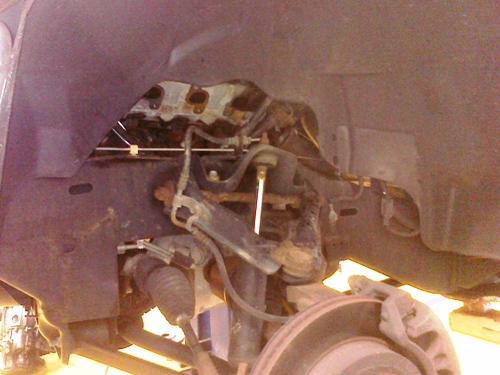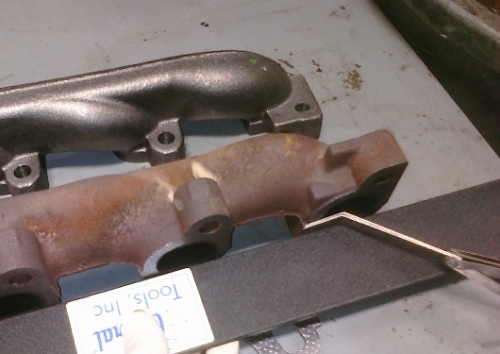Dodge 4.7 Exhaust Noise on Cold Start Up – Dakota Ram Durango
September 4, 2010 9:47 am Chry. 4.7 Problems, How To Auto Repair, TIME-SERT Kits© DenLorsTools.com Summary: Dodge 4.7 engines ticking or tapping noise upon cold start-up is a very common problem. As the picture above indicates, exhaust manifolds and gaskets are usually the cause. Affected vehicles are Dodge Dakota pick up trucks, Dodge Durango SUVs and full size Dodge Rams equipped with 4.7 Liter engines. This auto repair article points out some of the things to look for when replacing the exhaust manifold gaskets on one of these trucks. Failure to inspect the exhaust manifold closely may lead to a repeat gasket failure. Suggestions on how to repair the problem right the first time – and the #1 cause of repeated failure is pointed out. It’s obvious once you know what to look for.
With the wheel removed access can be gained for inspection and removal.
Dodge 4.7 engines that have a tapping noise for a few minutes when first started up could have one of several problems. This auto repair article covers exhaust manifold gasket leaks on trucks due to exhaust manifold studs breaking. Be sure to see the related articles linked below for a different common issues that some 4.7 engines have.
Access can be gained in most cases over the frame in the wheel well area.
Inspecting for Broken Studs
Look for broken exhaust studs. Usually the exhaust manifold itself will NOT be cracked on this model. Typically there will be at least one broken exhaust manifold stud. With the heat shield obstructing the view of some of the studs, it can a little difficult to find a broken stud. Usually on this truck it will be one of the rear ones that break. Once the exhaust manifold stud is broken, exhaust gases will then be allowed to escape between the cylinder head and exhaust manifold past the gasket. When the engine warms up, the noise is less because heat expansion helps to close the gap. With the manifold and cylinder head fitting closer together, less exhaust escapes – this is why the noise usually subsides somewhat as the vehicle reaches operating temperature.
Removing Broken Studs
After removing the exhaust manifold, hopefully the broken stud will NOT be broken off flush. A protruding stud is much easier to deal with. If it is sticking out far enough, it can be removed with a pair of vise grips or specialty stud removal tool. If the stud is broken off even with the head, removal won’t be nearly as easy. Drilling the stud is the next step. It’s best to use a center punch to provide a starting point for the drill bit in the middle of the stud. Sometimes using a left hand drill bit is an effective way to remove a broken stud with minimal effort. With a little luck when drilling counter-clockwise with a left-handed drill bit, the broken stud will back out! If using a regular right hand dill bit, this would never happen. If the stud was free to spin at all it would only tighten more. If the stud doesn’t come out while drilling with a left hand drill bit, an easy out will need to be used. Caution: DO NOT use excessive force on the easy out! A broken easy out is a nightmare to remove. The metal that an easy out is made of is hard and brittle making it virtually impossible to drill out. As a last resort using a thread insert kit (like Heli-Coil or Time-Sert) may be necessary to restore the threads.
Use a straight edge to check for manifold warp-age.
Inspecting the Exhaust Manifold
After cleaning the gasket material off the exhaust manifold, a straight edge can be used to make sure it is reusable. Exhaust manifolds can warp so it is imperative that it is checked prior to just replacing the gasket and broken studs. Placing a straight edge on the manifold as shown in the image above, it will be obvious if the surface of the manifold is straight or warped. The feeler gauge in the image above helps to illustrate how much warpage has occurred. The manifold in this situation has to be replaced. If it was not replaced, a repeat failure would occur. This is the key to having a long-term repair or having to do the repair over again prematurely.
Related Tools
Left Hand Drill Bit and Easy Out Extractor Kit
Bolt and Screw Extractor Specialty Tools




Carl Ervin :
Date: September 7, 2010 @ 2:42 pm
Thank you for your help. I feel more confident now that I’m armed with some knowledge. I want to replace the OEM exhaust bolts with some that are stronger. However, by doing so I will not be able to reuse the heat shield. How important is the heat shield? It seems to me that the header itself would be subjected to more airflow if the heat shield was left off.
dennisb - Auto Tool Sales :
Date: September 7, 2010 @ 3:15 pm
Carl, You may want to ask the manufacturer of the headers you are going to be using, what the temperature difference may be for your application. If necessary, you may also want to check out options for header insulation like a custom heat shield, ceramic paint, a thermal barrier coating or heat wrap. Hopefully your your header source will be able to help make recommendations.
Eli :
Date: October 29, 2010 @ 8:52 am
I got rid of my factory heat shield on my 00 jeep grand 4.7 and went with heat wrap. Works better than the little factory heat shield. The factory heat shield just blocks the constant heat in that direction.
dennisb - Auto Tool Sales :
Date: June 10, 2023 @ 10:00 am
See a more recent article on exhaust manifold stud removal and rethreading. https://www.wiseautotools.com/blog/dealing-with-broken-exhaust-manifold-studs-drilling-removal-extraction-and-rethreading/